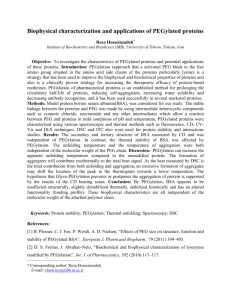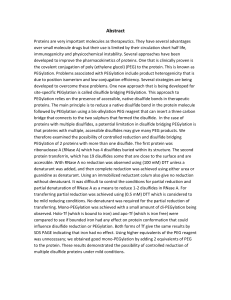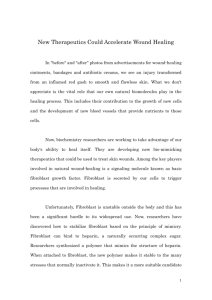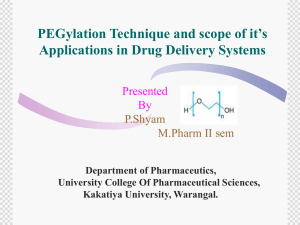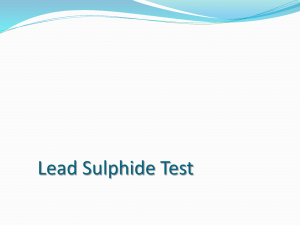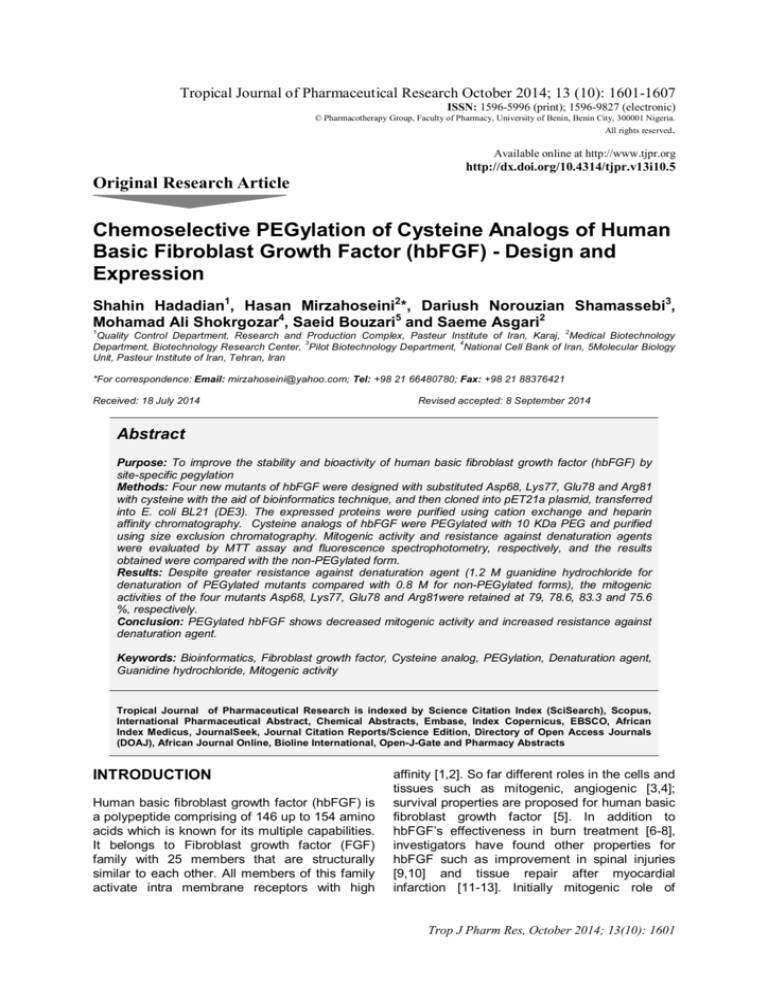
Hadadian et al
Tropical Journal of Pharmaceutical Research October 2014; 13 (10): 1601-1607
ISSN: 1596-5996 (print); 1596-9827 (electronic)
© Pharmacotherapy Group, Faculty of Pharmacy, University of Benin, Benin City, 300001 Nigeria.
All rights reserved.
Available online at http://www.tjpr.org
http://dx.doi.org/10.4314/tjpr.v13i10.5
Original Research Article
Chemoselective PEGylation of Cysteine Analogs of Human
Basic Fibroblast Growth Factor (hbFGF) - Design and
Expression
Shahin Hadadian1, Hasan Mirzahoseini2*, Dariush Norouzian Shamassebi3,
Mohamad
Ali Shokrgozar4, Saeid Bouzari5 and Saeme Asgari2 2
1
Quality Control Department, Research and Production Complex, Pasteur Institute of Iran, Karaj, Medical Biotechnology
3
4
Department, Biotechnology Research Center, Pilot Biotechnology Department, National Cell Bank of Iran, 5Molecular Biology
Unit, Pasteur Institute of Iran, Tehran, Iran
*For correspondence: Email: mirzahoseini@yahoo.com; Tel: +98 21 66480780; Fax: +98 21 88376421
Received: 18 July 2014
Revised accepted: 8 September 2014
Abstract
Purpose: To improve the stability and bioactivity of human basic fibroblast growth factor (hbFGF) by
site-specific pegylation
Methods: Four new mutants of hbFGF were designed with substituted Asp68, Lys77, Glu78 and Arg81
with cysteine with the aid of bioinformatics technique, and then cloned into pET21a plasmid, transferred
into E. coli BL21 (DE3). The expressed proteins were purified using cation exchange and heparin
affinity chromatography. Cysteine analogs of hbFGF were PEGylated with 10 KDa PEG and purified
using size exclusion chromatography. Mitogenic activity and resistance against denaturation agents
were evaluated by MTT assay and fluorescence spectrophotometry, respectively, and the results
obtained were compared with the non-PEGylated form.
Results: Despite greater resistance against denaturation agent (1.2 M guanidine hydrochloride for
denaturation of PEGylated mutants compared with 0.8 M for non-PEGylated forms), the mitogenic
activities of the four mutants Asp68, Lys77, Glu78 and Arg81were retained at 79, 78.6, 83.3 and 75.6
%, respectively.
Conclusion: PEGylated hbFGF shows decreased mitogenic activity and increased resistance against
denaturation agent.
Keywords: Bioinformatics, Fibroblast growth factor, Cysteine analog, PEGylation, Denaturation agent,
Guanidine hydrochloride, Mitogenic activity
Tropical Journal of Pharmaceutical Research is indexed by Science Citation Index (SciSearch), Scopus,
International Pharmaceutical Abstract, Chemical Abstracts, Embase, Index Copernicus, EBSCO, African
Index Medicus, JournalSeek, Journal Citation Reports/Science Edition, Directory of Open Access Journals
(DOAJ), African Journal Online, Bioline International, Open-J-Gate and Pharmacy Abstracts
INTRODUCTION
Human basic fibroblast growth factor (hbFGF) is
a polypeptide comprising of 146 up to 154 amino
acids which is known for its multiple capabilities.
It belongs to Fibroblast growth factor (FGF)
family with 25 members that are structurally
similar to each other. All members of this family
activate intra membrane receptors with high
affinity [1,2]. So far different roles in the cells and
tissues such as mitogenic, angiogenic [3,4];
survival properties are proposed for human basic
fibroblast growth factor [5]. In addition to
hbFGF’s effectiveness in burn treatment [6-8],
investigators have found other properties for
hbFGF such as improvement in spinal injuries
[9,10] and tissue repair after myocardial
infarction [11-13]. Initially mitogenic role of
Trop J Pharm Res, October 2014; 13(10): 1601
Hadadian et al
hbFGF on fibroblastic cells and tissues repair
was considered then the function of hbFGF as
neurotrophic activity in the growth and survival of
brain's neuron, assisting the survival of
transplanted neuron and prevention of apoptotic
neuronal cells was confirmed [14]. The first
commercial drug namely Trafermin is available in
global market for providing numerous health
benefits [15-17].
As hbFGF is a proteinicious molecule therefore,
its stability and half life are susceptible to be
reduced like other proteins by proteolysis like
other
proteins
[18,19].
PEGylation
of
recombinant therapeutic proteins is considered
as a technique that increases the stability of a
molecule [20,19], with retention of activity [2125,20].
Random or non-specific PEGylation such as N
terminal PEGylation and lysine PEGylation which
belong to the first generation of PEGylation make
a heterogenic low efficiency and less bioactive
product. Improvement of PEGylation led to the
second generation or site–specific PEGylation
method which gave more stable and efficient
products [26].
One of the methods used to increase the
probability of binding the protein molecule under
study is the employment of an activated form of
polyethylene
glycol(PEG
maleimide)
and
presence of an amino acid namely cysteine
where such amino acid is designed to be located
at non functional and non protective sites of the
protein under PEGylation. PEGylation is
performed in different environmental situations
like room temperate or cold room with various
incubation times. PEGylation is an exothermic
reaction so generally, it is recommended to
perform in a cold situation. At room temperature,
PEGylation incubation is shorter than cold room
[19,27-29,].
Like other therapeutic proteins, hbFGF has been
one of the attractive targets for PEGylation
[19,29]. In the present study, by employing
bioinformatics programs such as Modeller and
Prosite and molecular dynamic simulation [30],
the molecular structure, active site of the
molecule and the protected sites of hbFGF were
identified and studied. By considering points
such as presence of cysteine at the surface and
being away from protected sites, four mutants
were
designed.
Such sequences
were
constructed, inserted into pET21a plasmids and
transformed into E. coli BL21 (DE3).
EXPERIMENTAL
Bioinformatics analyses
The primary sequence of human basic fibroblast
growth factor was obtained from the Uniprot
database (Accession No P09038). 3D structures
of cysteine analogs were generated by homology
modeling using MODELLER version 9v13 and a
crystal structure of FGF2 (PDB code: 1BFG,
chain A, 1.6 oA) with high score and lower evalue and maximum sequence identity served as
a template. For each cysteine analog, 10,000
molecules were generated and structure quality
was validated by PSVS (http:// psvs-1_4dev.nesg.org/). The best structural model was
chosen for further studies. The stability of
modeled analogs was examined by MD
simulation. GROMACS 4.6.5 package and
GROMOS96 53a6 force field were used on
LINUX architecture for energy minimization and
MD simulations. All simulations were performed
at normal pressure (1 bar) and temperature (300
K) for 5 ns.
A literature review was performed to find
conserved residues; based on this, sequences
66-96 was the best region for manipulation and
replacement with cysteine. The 3D structures of
selected analogs were generated and screened
based on the basis of protein energy according
to the internal scoring function of Modeller. Four
analogs (Asp 68, Lys77, Glu78 and Arg81) were
chosen based on minimum protein energy and
minimum Root-Mean-Square Deviation (RMSD)
from native bFGF in the final average structure,
for experimental analysis. The quality of modeled
analogs was verified by ramachandran plot.
Superimposed native bFGF and Cysteine
analogs were selected (Asp 68, Lys77, Glu78,
Arg81). MD analysis was performed for all
analogs in 5 ns, and model stability and average
structure calculations were evaluated using the
plot of RMSD versus time.
Construction, expression and purification of
cysteine analogs of hbFGF
The resultant sequences were constructed
(Biomatik Corporation, Canada), and cloned into
pET21a plasmid, then transferred to E. coli BL21
(DE3) by using One Shot® BL21(DE3)
Chemically Competent E. coli (Invitrogen). The
engineered E. coli BL21 (DE3) was grown in LB
broth (Sigma-Aldrich) till reaching an optical
density (OD600 nm) ≈ 0.6 - 1.0. The induction of
hbFGF was carried out with 1 mM Isopropyl β-D1-thiogalactopyranoside
[IPTG]
(Thermo
Scientific, Fermentas) at 30 °C for 4 h. The cells
Trop J Pharm Res, October 2014; 13(10): 1602
Hadadian et al
were harvested by centrifugation at 2000 rpm, 4
°C for 20 min. They were suspended in
phosphate buffer, passed through high pressure
homogenizer and cell debris was separated by
centrifugation. The expressed proteins were
confirmed by SDS PAGE 12 % and Western blot
(semi dry) analysis.
The supernatant containing hbFGF were purified
by Fast Purification liquid chromatography FPLC
(Bio-Rad) in two steps using cation exchange
chromatography (Sartobind S membrane:
Sartorius
Co)
and
heparin
affinity
chromatography (HiTrap, GE Health Care Life
Sciences), both at a flow rate of 1 ml/min. The
resultant peaks were subjected to SDS-PAGE 12
% to identify the target protein. The collected
peak was buffer exchanged and concentrated to
reduce the salt concentration with Vivaspin
sample concentrator 10 KDa (GE Health Care
Life Sciences). Anion exchange column
(Sartobind Q membrane: Sartorius Co) was
applied at a flow rate of 1 ml/min for endotoxin
reduction to desired level where it does not affect
the biological activity assay.
PEGylation of purified cysteine analog hbFGF
The expressed and purified cysteine analogs
hbFGF proteins were subjected to PEGylation
using PEG-maleimide 10 KD (Jenkem) under
nitrogen gas in a cold room for 24 h. The
PEGylated forms were separated from nonPEGylated
proteins
by
size
exclusion
chromatography using a Hiload 16/600 Superdex
75 prep grade column (GE Health care life
sciences) at a flow rate of 1 ml/min, analyzed by
12 % sodium dodecyl sulfate polyacrylamide gel
electrophoresis
[SDS-PAGE].
Stability
of
PEGylated and non-PEGylated forms of hbFGF
cysteine analog was studied by incubating them
in the presence of denaturing agent such as
guanidine HCl at 37 °C for 24 h. The effect of
such reagent was determined by fluorescence
spectrophotometry (Luminescence spectrometer
Perkin Elmer LS 50 B). PEGylated cysteine
analogs of hbFGF were used for MTT assay for
biological activity test. The results were
compared with non-PEGylated hbFGF.
Biological activity test
MTT assay was used to evaluate the biological
activity of the samples. Balb/c 3T3 cells from
mouse embryo tissue were cultivated in
Dulbecco's Modified Eagle's Medium (DMEM,
Gibco) containing 10 % FBS (Gibco). About
10000 cells/ml per well were added to plastic 96
well plates and cultured at 37°C for 2 h in a
humidified 5 % CO2 - 95 % air atmosphere. The
cells were treated with different concentrations of
hbFGF mutants. The assay was going on using
the MTT exclusion dye which reacts only with
viable cells. observed Optical density (OD)
measured by ELISA reader shows the amount of
the alive cells. The range of sample
concentration was from 15 pg/ml up to 2000
pg/ml. The MTT assay was used for PEGylated
form too. The results were compared with bFGF
standard curve.
RESULTS
Bioinformatics results
The sequences under study through whose
mutants were made up, were blasted by Protein
Data Base and the most aligned sequence (> 98
% alignment) belonged to fibroblast growth factor
variant bearing the number P09038 [FGF2Human] 1BFG (R090p38).
The sequence under study contains 9 amino
acids less than the sequence 1BFG (R090p38)
which contains 154 amino acids located at the
beginning of the sequence. These two
sequences differ at amino acids numbers 21, 96
and 97 where our sequence alanine, serine and
alanine were replaced with phenylalanine,
cysteine and valine respectively. Our constructed
sequences along with the file bearing suffix PDB
related to 1BFG (R090p38) were subjected to
Modeller software with the aim of increasing
accuracy and sensitivity of the resultant
information, thus 10,000 molecules were
generated and the molecule corresponding to the
lowest value of probability density function was
selected.
In continuation by using multiple sequence
alignment and prosite software, the protected
sites in this family and also the available motifs
were extracted in order to make convergence
comparison through the related literature [31-33].
The results are as follows: the binding receptor
sites include amino acids 25-69 and 94-121
where amino acids 31-51 and 107-116 play
fewer roles in binding. The binding site of this
protein/molecule to heparin includes the
sequence 94-121,104-147 and 106-142. The
regions 128-138 create a loop-like area that
plays a major role in binding to heparin. Finally,
the regions 66-96 were selected as the best
amino acid regions to substitute the available
amino acids with cysteine. The first selected
mutant was made by substitution of asparlate 68
with cysteine. The quality of models was checked
using discrete optimized protein energy (DOPE),
Trop J Pharm Res, October 2014; 13(10): 1603
Hadadian et al
PROCHECK software and ramachandran plots
indicating that more than 93% residues were
located in the favoured region and no residue
was present in the disallowed region(Table 1).
Other three mutants were obtained in a similar
manner.
Since the results of the four mutants are similar,
only the results of cysteine hbFGF analog Asp68
are presented. Figure 2 shows SDS-PAGE
(12%) and western blot analysis confirmation of
Asp68.
The RMSD of the backbone atoms of the protein
over the course of simulation is usually used as a
measure of the conformational stability of the
protein. RMSD of analog proteins with native
hbFGF were compared using NAMD software
indicating similarity between native BFGF and
Asp 68, Lys77, Glu78, Arg81analogs.
Experimental results
The engineered bacteria containing the gene of
interest in their plasmid were allowed to grow in
LB medium; induction was achieved with 1 mM
IPTG. Protein expressions of various mutants
were compared at 4 and 6 h after induction and
no significant differences were detected (Figure
1).
Fig 2: SDS PAGE of 2 steps purification and Western
blot of mutated forms and the standard hbFGF: 2-1)
Lane A: Heparin affinity peak; Lane B: fraction 2 of
cation exchange, Lane C: fraction 1 of cation
exchange; Lane D: Marker; 2-2) western blot of: Lane
E: Asp68; Lane F: Lys77; Lane G: Glu78; Lane H:
Arg81
The purified 4 mutants were used for MTT assay
to determine their biological activity using balb/c
3T3 clone A 31. The MTT results showed the
similarity of the 4 mutants to the normal variant
(data not shown).
Fig1: SDS PAGE expressed proteins. Lane A: marker;
lanes B-D: Asp68 before induction,4 and 6 hours after
induction; lane E-G: similar time for Lys77; lanesH – J:
similar times for Glu78 and lane K-M: similar times for
Arg81
PEGylation of the purified proteins were
performed in the dark, in a cold room under a
stream of nitrogen gas using PEG-maleimide 10
kD. PEGylated forms were separated from the
non-PEGylated hbFGF with size exclusion
chromatography and further were confirmed by
SDS-PAGE 12 % (Figure 3).
Table 1: Structural validation of model structure generated from Modeler by PSVS
Sample name
Most favoured
regions (%)
Allowed
regions (%)
Generously allowed
regions (%)
Disallowed
regions (%)
Wild bFGF
96.7
3.3
0.0
0.0
N68C
93.4
6.6
0.0
0.0
K77C
E78C
94.2
93.4
5.8
5.8
0.0
0.8
0.0
0.0
G81C
94.2
5.8
0.0
0.0
Trop J Pharm Res, October 2014; 13(10): 1604
Hadadian et al
Fig. 3: Size exclusion chromatography and SDS-PAGE of PEGylated and non-PEGylated forms of mutated
proteins after size exclusion chromatography. (3-1): Lane A: Asp 68; Lane B: Lys77; Lane C: Glu78; Lane D:
Arg81; Lane E: PEGy Asp68; Lane F: PEGy Lys77; Lane G: PEGy Glu78; Lane H: PEGy Arg81.(3-2) Size
exclusion chromatogram
Fig 4: Fluorescence spectroscopy of four native mutants and Asp68 in steps of natural and denature forms. Left:
nature forms of 1: Asp 68, 2: Lys77; 3: Glu78; 4: Arg81. Right: Asp68: 1: nature form; 2 and 3: denature forms in
two different concentrations
Both PEGylated and non-PEGylated forms of
purified hbFGF were converted to their
denatured forms in the presence of guanidine
HCl at 37 °C for 24 h. It was observed that
PEGylated human basic fibroblast growth factor
and non PEGylated forms of hbFGF were
denatured at 1.2 and 0.8 M concentrations of the
guanidine HCl denaturant respectively. Figure 4
shows the position of hbFGF in native, semi
denatured
and
denatured
forms
using
fluorescence spectrophotometry.
Finally the PEGylated forms of hbFGF were
subjected to biological assay in comparision with
Standard bFGF which revealed that 79, 78.6,
83.3 and 75.6 percent of mitogenic activity was
retained respectively in mutants Asp68, Lys77,
Glu78 and Arg81.
DISCUSSION
PEGylation is a well-known method for improving
the stability and efficiency of therapeutic proteins
[34-36]. PEGylation of hbFGF have done by a
limited research group. Some of them tried to
conjugate PEG molecules to native hbFGF [28]
and the others used site-specific method [19,29].
Mutants were created by replacing four amino
acids with cysteine (Asp68, Lys77, Glu78, Arg81)
through bioinformatics’ prediction, and were
expressed at a high level in E. coli BL21 (DE3).
We used two chromatographic method which
include cation exchange and heparin affinity to
achieve more than 95 percent purity. In addition,
an anion exchange chromatography was further
used to reduce endotoxin before MTT assay.
Bioactivity of the 4mutants was same and equal
to standard hbFGF. Purified cysteine analog
hbFGF was PEGylated using PEG-maleimide
Trop J Pharm Res, October 2014; 13(10): 1605
Hadadian et al
(10 KDa) in the dark and in the cold room under
nitrogen gas for 24 h.
ovine
placenta
during
the
third
trimester
of
pregnancy. Biol Reprod 1997; 56(5): 1189-1197.
6. Akita S, Akino K, Imaizumi T, Hirano A. A basic fibroblast
PEGylated and non-PEGylated proteins were
separated using size exclusion chromatography
and their fractions were run on 12 % SDS PAGE.
PEGylated proteins were larger than the
expected size (Figure 3), probably due to the
more extended structure of PEG-protein
conjugate [19]. Our result shows that bioactivity
of PEGylated hbFGF was less than the nonPEGylated form. The reduction in bioactivity of
PEGylated protein had been reported by other
researchers [28,19,29] and there is a one theory
that PEGylation makes the protein more stable
but may shield the active site of protein partially
[19]. Stability of hbFGF is measured using
different methods such as heat-stability [29],
resistance to denaturing agent like guanidine
hydrochloride (GuHCl) and or urea using
fluorescence spectroscopy [37]. We used
resistance to guanidine hydrochloride (GuHCl)
method and showed that the PEGylated hbFGF
increased stability up to 1.2 molar GuHCl
compared with 0.8 molar for the non-PEGylated
mutant.
growth factor improved the quality of skin grafting in
burn patients. Burns 2005; 31(7): 855-858.
7. Akita S, Akino K, Imaizumi T, Hirano A. Basic fibroblast
growth factor accelerates and improves seconddegree burn wound healing. Wound Repair Regen
2008; 16(5): 635- 641.
8. Gibran NS, Isik FF, Heimbach DM, Gordon D. Basic
fibroblast growth factor in the early human burn
wound. J Surg Res 1994; 56(3): 226-234.
9. Rabchevsky AG, Fugaccia I, Fletcher-Turner A, Blades
DA, Mattson MP, Scheff SW. Basic fibroblast growth
factor (bfgf) enhances tissue sparing and functional
recovery following moderate spinal cord injury. J
Neurotrauma 1999; 16(9): 817-830.
10. Rabchevsky AG, Fugaccia I, Turner AF, Blades DA,
Mattson MP, Scheff SW. Basic fibroblast growth
factor (bfgf) enhances functional recovery following
severe spinal cord injury to the rat. Exp Neurol 2000;
164(2): 280-291.
11. Hu B. immunohistochemical study of basic fibroblast
growth factor of early myocardial infarction. Fa Yi Xue
Za Zhi 2000; 16(4): 205-207, S201.
12. Uchida Y, Yanagisawa-Miwa A, Nakamura F, Yamada K,
ACKNOWLEDGEMENT
Tomaru T, Kimura K, Morita T. Angiogenic therapy of
acute
This project was financially supported by the
Pasteur Institute of Iran via the sponsorship of
the PhD thesis of Shahin Hadadian.
myocardial
infarction
by
intrapericardial
injection of basic fibroblast growth factor and heparin
sulfate: An experimental study. Am Heart J 1995;
130(6): 1182-1188.
13. Yamamoto M, Sakakibara Y, Nishimura K, Komeda M,
REFERENCES
Tabata
Y.
cardiomyocyte
1. Ornitz DM, Xu J, Colvin JS, McEwen DG, MacArthur CA,
Coulier F, Gao G, Goldfarb M. Receptor specificity of
the fibroblast growth factor family. J Biol Chem 1996;
Improved
therapeutic
transplantation
for
efficacy
in
myocardial
infarction with release system of basic fibroblast
growth factor. Artif Organs 2003; 27(2): 181-184.
14. Ohta H, Ishiyama J, Saito H, Nishiyama N. Effects of
pretreatment with basic fibroblast growth factor,
271(25): 15292-15297.
2. Zhang Y, Gorry MC, Post JC, Ehrlich GD. Genomic
epidermal growth factor and nerve growth factor on
organization of the human fibroblast growth factor
neuron survival and neovascularization of superior
receptor 2 (fgfr2) gene and comparative analysis of
cervical ganglion transplanted into the third ventricle
the human fgfr gene family. Gene 1999; 230(1): 69-
in rats. Jpn J Pharmacol 1991; 55(2): 255-262.
15. Takemoto K, Komatsu S, Okamoto K, Ichikawa D,
79.
3. Chuah MI, Teague R. Basic fibroblast growth factor in the
Shiozaki A, Fujiwara H Murayama Y, Kuriu Y, Ikoma
effect on
H, Nakanishi M et al. A novel treatment strategy
ensheathing cells. Neuroscience 1999; 88(4): 1043-
using trafermin, containing basic fibroblast growth
1050.
factor, for intractable duodenal fistula following
primary
olfactory pathway: Mitogenic
4. Peyrat JP, Bonneterre J, Hondermarck H, Hecquet B,
curative gastrectomy for gastric cancer-case report
Adenis A, Louchez MM, Lefebvre J, Boilly B,
and literature review. Gan To Kagaku Ryoho 2012;
Demaille A. Basic fibroblast growth factor (bfgf):
39(12): 1960-1962.
Mitogenic activity and binding sites in human breast
16. Yamaguchi S, Asao T, Nakamura J, Tsuboi K, Tsutsumi
cancer. J Steroid Biochem Mol Biol 1992; 43(1-3): 87-
S ,Kuwano H. Effect of basic fibroblast growth factor,
94.
trafermin, on entero-related fistulae, report of two
5. Zheng J, Vagnoni KE, Bird IM, Magness RR. Expression
of basic fibroblast growth factor, endothelial mitogenic
activity, and angiotensin ii type-1 receptors in the
cases. Hepatogastroenterology 2007; 54(75): 803805.
17. Yuge T, Furukawa A, Nakamura K, Nagashima Y,
Shinozaki K, Nakamura T ,Kimura R. Metabolism of
the intravenously administered recombinant human
Trop J Pharm Res, October 2014; 13(10): 1606
Hadadian et al
basic fibroblast growth factor, trafermin, in liver and
kidney: Degradation
implicated
in
its
28. Huang Z, Ye C, Liu Z, Wang X, Chen H, Liu Y, Tang L,
selective
Zhao H, Wang J, Feng W et al. Solid-phase n-
localization to the fenestrated type microvasculatures.
terminus pegylation of recombinant human fibroblast
Biol Pharm Bull 1997; 20(7): 786-793.
growth factor 2 on heparin-sepharose column.
18. Batra J, Robinson J, Mehner C, Hockla A, Miller E,
Radisky
DC,
Radisky
ES.
Pegylation
Bioconjug Chem 2012; 23(4): 740-750.
extends
29. Wu X, Liu X, Xiao Y, Huang Z, Xiao J, Lin S, Cai L, Feng
circulation half-life while preserving in vitro and in vivo
W, Li X. Purification and modification by polyethylene
activity of tissue inhibitor of metalloproteinases-1
glycol of a new human basic fibroblast growth factor
(timp-1). PLoS One 2012; 7(11): e50028.
mutant-hbfgf(ser25,87,92). J Chromatogr A 2007;
19. Wu X, Li X, Zeng Y, Zheng Q, Wu S. Site-directed
pegylation of human basic fibroblast growth factor.
Protein Expr Purif 2006; 48(1): 24-27.
of ph stability of uricase via inhibitive tetramer
dissociation. J Pharm Pharmacol 2013; 65(1): 53-63.
21. Kaminskas LM, Ascher DB, McLeod VM, Herold MJ, Le
CP, Sloan EK, Porter CJ. Pegylation of interferon
improves
lymphatic
B,
Raemdonck
Demeester
20. Tian H, Guo Y, Gao X, Yao W. Pegylation enhancement
alpha2
1161(1-2): 51-55.
30. Naeye
exposure
after
J,
De
K,
Remaut
Smedt
K,
SC.
Sproat
B,
Pegylation
of
biodegradable dextran nanogels for sirna delivery.
Eur J Pharm Sci; 40(4): 342-351.
31. Eriksson AE, Cousens LS, Weaver LH, Matthews BW.
Three-dimensional
structure
of
human
basic
fibroblast growth factor. Proceedings of the National
Academy of Sciences 1991; 88(8): 3441-3445.
subcutaneous and intravenous administration and
32. Presta M, Rusnati M, Urbinati C, Sommer A ,Ragnotti G.
improves antitumour efficacy against lymphatic breast
Biologically active synthetic fragments of human
cancer metastases. J Control Release 2013; 168(2):
basic fibroblast growth factor (bfgf): Identification of
200-208.
two asp-gly-arg-containing domains involved in the
22. Lee JI, Eisenberg SP, Rosendahl MS, Chlipala EA,
Brown JD, Doherty DH, Cox GN. Site-specific
mitogenic activity of bfgf in endothelial cells. J Cell
Physiol 1991; 149(3): 512-524.
pegylation enhances the pharmacokinetic properties
33. Presta M, Rusnati M, Urbinati C, Statuto M, Ragnotti G.
and antitumor activity of interferon beta-1b. J
Functional domains of basic fibroblast growth factor.
Interferon Cytokine Res 2013; 33(12): 769-777.
Possible role of asp-gly-arg sequences in the
23. Pfister D, Morbidelli M. Process for protein pegylation. J
Control Release 2014; 80: 134-149.
mitogenic activity of bfgf. Ann N Y Acad Sci 1991;
638: 361-368.
24. Simon M, Stefan N, Borsig L, Pluckthun A ,Zangemeister-
34. Francis GE, Fisher D, Delgado C, Malik F, Gardiner A,
Wittke U. Increasing the antitumor effect of an
Neale
epcam-targeting
therapeutic proteins and peptides: The importance of
fusion
toxin
by
facile
click
pegylation. Mol Cancer Ther; 13(2): 375-385.
D.
Pegylation
of
cytokines
and
other
biological optimisation of coupling techniques. Int J
25. Tagalakis AD, Kenny GD, Bienemann AS, McCarthy D,
Hematol 1998; 68(1): 1-18.
Munye MM, Taylor H, Wyatt MJ, Lythgoe MF, White
35. Gaberc-Porekar V, Zore I, Podobnik B, Menart V.
EA, Hart SL. Pegylation improves the receptor-
Obstacles and pitfalls in the pegylation of therapeutic
mediated transfection efficiency of peptide-targeted,
proteins. Curr Opin Drug Discov Devel 2008; 11(2):
self-assembling, anionic nanocomplexes. J Control
Release 2014; 174: 177-187.
26. Roberts MJ, Bentley MD, Harris JM. Chemistry for
peptide and protein pegylation. Adv Drug Deliv Rev
2002; 54(4): 459-476.
27. Cohan
RA,
Madadkar-Sobhani
242-250.
36. Harris JM, Martin NE, Modi M. Pegylation: A novel
process
37. Estape
A,
Khanahmad
for
modifying
pharmacokinetics.
Clin
Pharmacokinet 2001; 40(7): 539-551.
DVDH,
Joop;
Rinas,
Ursula.
Susceptibility
H,
towards intramolecular disulphide-bond formation
Roohvand F, Aghasadeghi MR, Hedayati MH, Barghi
affects conformational stability and folding of human
Z, Ardestani MS, Inanlou DN, Norouzian D. Design,
basic fibroblast growth factor. Biochem J 1998; 335:
modeling, expression, and chemoselective pegylation
343–349.
of a new nanosize cysteine analog of erythropoietin.
Int J Nanomedicine 2011; 6: 1217-1227.
Trop J Pharm Res, October 2014; 13(10): 1607

